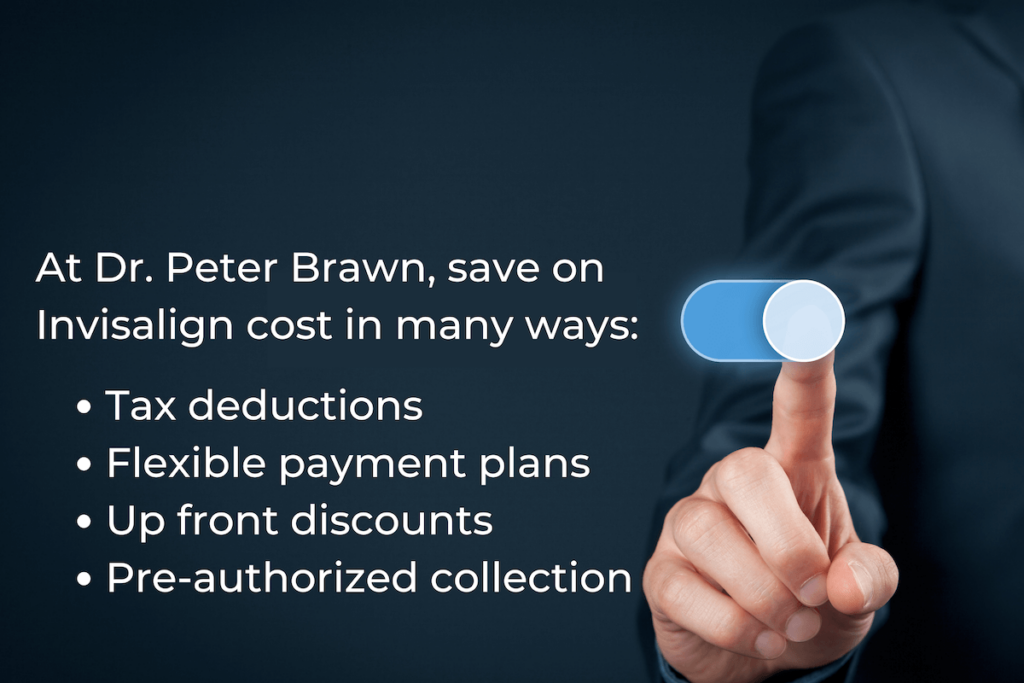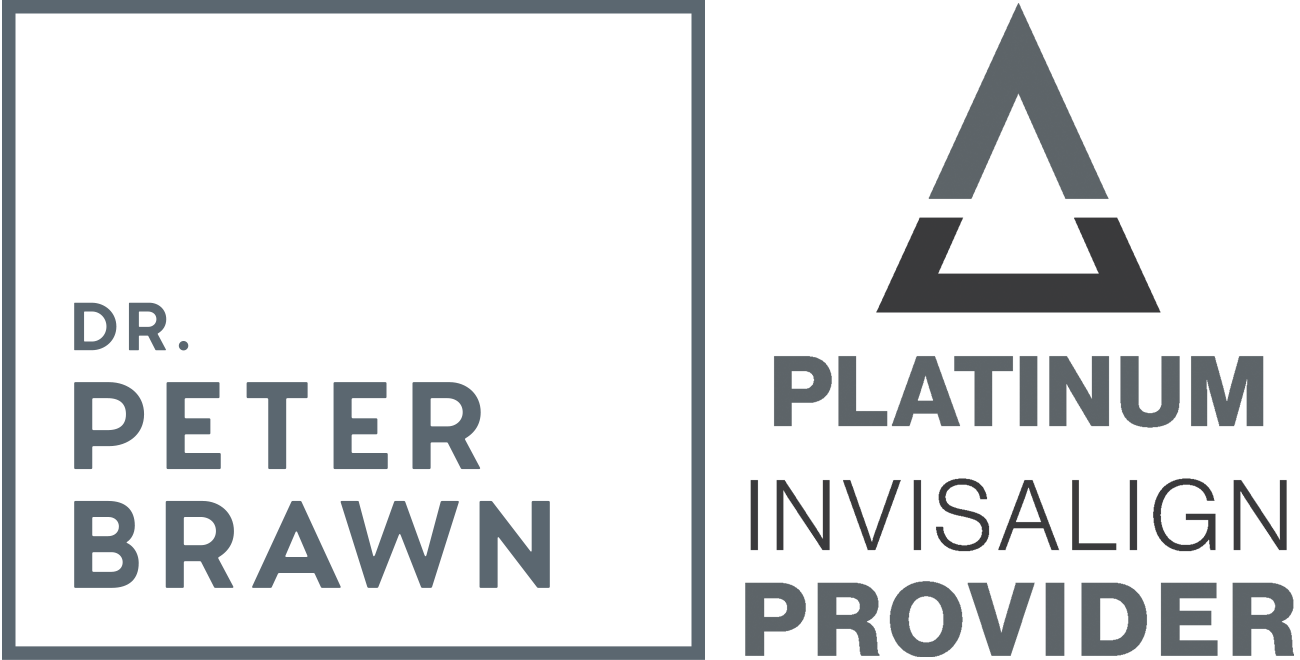
You’re going to like what we have to say about Invisalign dental insurance coverage.
If your dental plan includes orthodontic treatment coverage, some of your medical expenses for Invisalign will be covered by insurance.
In this post, we’ll help you understand how dental insurance plans work, how to know if your dental insurance company will cover Invisalign treatment, and 3 key things you’ll want to know about Invisalign dental insurance coverage in Canada.
Dental Insurance & Orthodontic Coverage in Canada
What plans cover orthodontic treatment?
In Canada, dental plans that cover orthodontic treatment will state that ‘orthodontic coverage’ is included in your insurance policy. You’ll find it under major services in your plan.
If you already have health insurance through an insurance provider and you’re wondering what to look for, start by reviewing your dental insurance contract for ‘orthodontic coverage’.
Orthodontic insurance (or ‘orthodontics coverage’) is what covers both traditional braces and Invisalign orthodontic treatment.
Do all plans cover the same dental services & preventive care?
Not all dental plans have exactly the same coverage. Some have extensive coverage while others cover only basic dental treatments. Many orthodontic insurance plans cover braces and Invisalign for children but not for adults. Others don’t cover any orthodontic services at all.
Be sure to review your orthodontic insurance plan thoroughly and understand what coverage you will get for your orthodontic treatment.
Are braces covered by insurance?
The cost of braces can be covered by insurance if you have orthodontic insurance in your policy. Braces coverage is not guaranteed in your dental plan and is not included for all individuals.
We encourage you and all our patients to check with your insurance provider before assuming your treatment plan will be covered. If you’re not sure, come in for a free consultation and we can help you know what to ask.
Does insurance cover Invisalign? (The answer for Canada)
If your dental insurance plan includes orthodontic coverage, insurance will cover a portion of your Invisalign treatment.
Make sure to know what your specific health insurance plan covers. Some plans only cover adults, some only cover children, and some don’t cover anything at all. If you’re not sure what to ask, we can help.
When dental insurance policies do include coverage for Invisalign (i.e. ‘orthodontics’), typically the plan covers a specific percentage of the total fee up to a lifetime maximum – often with a fixed dollar amount. Usually, that adds up to about $2,000 – $3,000 in savings for you.
For example: if your lifetime maximum (LTM) is $3,000 with a 50% rate and your treatment fees are $8,000, your benefit will be $3,000 (because that is your LTM) even though $4,000 would be 50% of your treatment fees. Your provider will pay 50% of treatment costs up to $3,000.
(Humorously, that’s the same amount of benefits and the same lifetime maximum you would’ve received in 1975 – your insurance company has not changed its lifetime cap since then.)
About half of our patients have orthodontic treatment coverage, and half do not. At Dr. Peter Brawn, we will contact your insurance company on your behalf to confirm your coverage and benefit amount for orthodontic services.
If you do have orthodontic benefits in your insurance and submit a treatment pre-authorization, we are able to collect the portion they pay directly and save you the hassle.
What Does Dental Coverage for Invisalign Typically Include?
Dental coverage for Invisalign typically includes all costs associated with your Invisalign treatment plan.
This doesn’t mean that insurance covers your entire fee for Invisalign treatment, but rather that your medical expenses for Invisalign will count as eligible.
Remember, your third-party insurance provider typically covers only a percentage of your total eligible fees. So, having all your fees count as eligible helps increase the amount insurance will pay you back.
Invisalign Insurance for Children vs. Adults
Not all plans and insurance companies cover orthodontics in the same way for the same age groups. Some plans only cover children. Some dental plans only cover adults. Some plans can and do cover the entire family. It will vary based on your plan.
There is one thing that is true with all plans: if your plan includes ‘orthodontics’ for the patient’s age group in your family, it will cover Invisalign.
How do I choose the right dental insurance plan for orthodontic care?
There are two key things to check for regarding your insurance benefits and what dental work they are committed to paying for.
1. Confirm the dental insurance plan covers orthodontic care
If it does, you will be able to save money on treatment for braces, Invisalign, and other orthodontic care.
2. Confirm the health insurance coverage amount for adults vs. children
This is just as key. What your insurance will pay for children vs. adults may be different. Depending on the plan and what age group you fall into, you may have maximum benefits or no benefits at all.
It’s key that you make sure your teeth are covered based on your age. We can help. We work with insurance companies almost every day and can help you with the right questions to ask and what to look for. Get your free consultation today, and we’ll set you up for success.

How to Know if Your Insurance Cover Invisalign
1. Review Your Policy
The first way to know if your insurance covers Invisalign is to confirm it’s in your policy. Review your policy looking to confirm it covers ‘orthodontics’. If it does, and it includes your age group (children, adults, or both), it will cover Invisalign.
2. Call your Insurance Company
If you’re not sure after reading your policy, give your insurance company a call. Their team will be able to confirm what is and isn’t included in your dental plan.
3. Get a Free Invisalign Consultation
If you strike out with option 1 and 2 above, we’re here to help. If you want to know if you can avoid metal braces and afford Invisalign instead, get a free consultation at Dr. Peter Brawn and we’ll help you understand the questions to ask and whether your insurance covers Invisalign.
p.s. We’ll also tell you about accelerated Invisalign treatment and how you can straighten teeth 2x faster than the average at other orthodontists in Vancouver.
How much does Invisalign cost with insurance?
It depends on the complexity of your case and the amount that your policy covers, but for most patients that we see with dental benefits, Invisalign will be about $2,000 – $3,000 less than the price they would pay otherwise.
It might surprise you to know that the cost of Invisalign in Vancouver, BC is very competitive with the cost of braces – between $5,500 – $10,000. At Dr. Peter Brawn, most patients pay between $5,500 – $7,900 to get straight teeth.
Here’s how the price of 5.0 rated Invisalign treatment at Dr. Peter Brawn compares against other treatments and averages at other doctors today.

3 Things to Know About Invisalign Dental Insurance Plans
1. It might not be worth it for you to purchase orthodontic coverage
In many cases, the amount of total Invisalign insurance benefit you would receive works out to be less than what you end up paying for the orthodontic insurance in the end.
Unfortunately, many patients make this easy mistake and purchase dental insurance for the quick payday and lose out in the end. Don’t pay more for straight teeth by rushing to buy a new dental plan.
2. You can use your FSA or HSA to cover braces or Invisalign
f you have an active FSA or HSA, you could use those funds to pay for braces or Invisalign and make getting straight teeth easier on your budget.
3. Invisalign is Tax-Deductible
Invisalign is tax deductible in Canada. You can use your fees for Invisalign as eligible medical expenses for a tax deduction. Consult with your tax adviser about how to claim these expenses and receive a tax credit on your income tax return.

Conclusion
Not everyone has Invisalign dental insurance coverage, but that doesn’t mean you can’t save on expenses while you get straight teeth. In your case, it might even make more sense to not purchase a new dental plan.
At Dr. Peter Brawn, we believe owning your best smile ought to be easy. We’ll work directly with you and your plan administrator to determine exactly how much you can save on Invisalign.
We’ll also help you get more results than other dental providers. Enjoy more than at a typical Vancouver orthodontist with benefits like:
- Finish treatment 2x faster than average Invisalign patients in Vancouver.
- Enjoy up to 75% less discomfort than typical treatment.
- Save time with half the appointments required elsewhere.
Get a free consultation and leave with a personalized plan for your specific case and how you can get more than at a different orthodontist in Vancouver.

FAQ About Orthodontic Insurance
I know that I have dental insurance. Does that mean I automatically have orthodontic coverage?
No, just because you have dental insurance does not mean you have orthodontic coverage. Be sure to ask your provider if they cover orthodontic treatment.
Also, be sure to ask if adults are covered since many plans provide only for minor dependents.
Will I receive my full benefit all at once?
Benefits pay out over the course of treatment, not in one lump sum payment. A preauthorization and treatment plan must be submitted to your provider for approval.
Part of this process is a breakdown of the total fee divided over the length of your treatment. Once approved, an initial claim (generally 30% of treatment fee) can be submitted for payment.
Then monthly claim payments would be submitted until your benefit is maximized. If you drop your dental/orthodontic plan before your benefit has finished paying, this can result in more out-of-pocket expenses for you.
Does your plan have a waiting period?
Some dental plans require a waiting period before they will pay for orthodontic services. They may cover cleaning and general dentistry immediately but require waiting periods before orthodontic coverage is active. Be sure to ask your provider about this.
What happens if I get insurance after I’ve already started treatment?
Sometimes an employer will increase their plan benefits or you might start a new position at a different employer and find yourself with benefits that you did not have when you first started treatment.
An orthodontic preauthorization and treatment plan would be sent to your provider for approval with an explanation that you are in mid-treatment and did not have access to these benefits at the beginning of your treatment.


